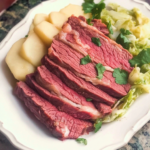Introduction to Corned Beef and Cabbage
Corned beef and cabbage is more than just a meal; it’s a symbol of Irish-American culture, especially during St. Patrick’s Day. This traditional dish has roots in Irish history, but it evolved in the United States, becoming a beloved staple in many households. Whether you’re a seasoned cook or a beginner, understanding the history and preparation of this dish can enrich your culinary experience.
History of Corned Beef and Cabbage
While many might assume that corned beef has its origins in Ireland, the reality is more nuanced. Corned beef was historically used in Ireland as a way to preserve beef through salt curing. However, it was the Irish immigrants in America who popularized the pairing of corned beef with cabbage, substituting it for the bacon and potatoes common in Ireland.
To dive deeper into the preparation and history of similar hearty meals, you can explore smoked meatloaf recipes which also emphasize slow cooking techniques and traditional flavors.
Key Ingredients
The main ingredients in this classic dish are simple but essential for an authentic taste:
- Corned Beef: Brisket is the preferred cut, renowned for its tenderness after slow cooking.
- Cabbage: Green cabbage is traditional, providing a slightly sweet and mild flavor that balances the salty beef.
- Vegetables: Commonly used vegetables include potatoes, carrots, and onions, which complement the dish and add texture.
- Spices: A blend of pickling spices such as mustard seeds, bay leaves, and peppercorns enhances the flavor profile.
If you’re interested in exploring other simple and hearty recipes, you might want to check out this easy ravioli lasagna that uses minimal ingredients for maximum flavor.
Preparation Methods
Stovetop Cooking Method
The traditional stovetop method is the most popular way to prepare corned beef and cabbage. This method involves simmering the beef for several hours to ensure tenderness.
Steps:
- Place the corned beef in a large pot with water.
- Add the spice packet that often comes with the beef.
- Simmer for 2.5 to 3 hours.
- Add the cabbage and other vegetables during the last 30 minutes of cooking.
For a recipe that shares some similarities in its slow, deliberate cooking process, you can explore this instant pot vegetable beef soup, which also emphasizes deep, robust flavors achieved through slow cooking.
Slow Cooker Method
Using a slow cooker is a convenient way to achieve tender, flavorful corned beef and cabbage without much hands-on time.
Steps:
- Place the corned beef in the slow cooker with water and spices.
- Add vegetables such as potatoes and carrots.
- Cook on low for 8-10 hours or high for 4-6 hours.
Instant Pot Method
The Instant Pot provides a quicker alternative without sacrificing flavor. This method is ideal for busy days when you still want to enjoy a homemade meal.
Steps:
- Add the corned beef and water to the Instant Pot with spices.
- Set to high pressure for 90 minutes.
- Use natural release and add vegetables, cooking for an additional 5-10 minutes.
Baking Method
For those who prefer a different texture, baking the corned beef is another option. This method results in a slightly crusted exterior while keeping the inside tender.

Steps:
- Preheat your oven to 350°F (175°C).
- Place the corned beef in a baking dish with water, cover, and bake for 2-3 hours.
- Add vegetables and bake uncovered for an additional 30 minutes.
Serving Suggestions and Variations
Once your corned beef and cabbage is ready, consider serving it with classic sides or trying some popular variations.
Traditional Serving Suggestions
- Soda Bread: This traditional Irish bread pairs well with the savory beef and vegetables.
- Mashed Potatoes: A creamy side that complements the richness of the dish.
Popular Variations
- Corned Beef Hash: A breakfast favorite made by frying diced corned beef with potatoes and onions.
- Reuben Sandwich: Use leftover corned beef for a sandwich with sauerkraut, Swiss cheese, and Russian dressing on rye bread.
Health Considerations
While corned beef is a delicious dish, it’s important to consider its nutritional content. Corned beef is high in sodium, so moderation is key. Rinsing the beef before cooking can help reduce sodium levels. Also, consider increasing the ratio of vegetables to meat for a more balanced meal.
For a healthier yet indulgent option, you might want to try almond flour banana muffins, which offer a sweet treat without the guilt.
Frequently Asked Questions (FAQs)
Why is Corned Beef Pink?
The pink color comes from the curing process, which typically involves sodium nitrite, preserving the meat and giving it its distinctive color.
Can You Freeze Cooked Corned Beef and Cabbage?
Yes, cooked corned beef and cabbage can be frozen for up to 2-3 months when stored in airtight containers.
How Long Can Leftovers Be Stored?
Leftovers can be stored in the refrigerator for up to 4 days. Reheat thoroughly before serving.
What is the Difference Between Corned Beef and Pastrami?
While both are made from beef, pastrami is typically smoked after curing, giving it a different flavor and texture.
Is Corned Beef Healthy?
Corned beef is rich in protein and certain vitamins but also high in sodium and fat. Enjoy it in moderation as part of a balanced diet.

Conclusion and Final Thoughts
Corned beef and cabbage is a dish steeped in tradition, offering a delicious blend of flavors and textures. Whether you’re preparing it for St. Patrick’s Day or just as a comforting family meal, the various methods outlined here provide flexibility to suit your preferences and schedule. So, roll up your sleeves and enjoy the process of making this timeless dish.
For more culinary inspiration, consider browsing other hearty and comforting recipes on Skilled Cooks. Happy cooking!




